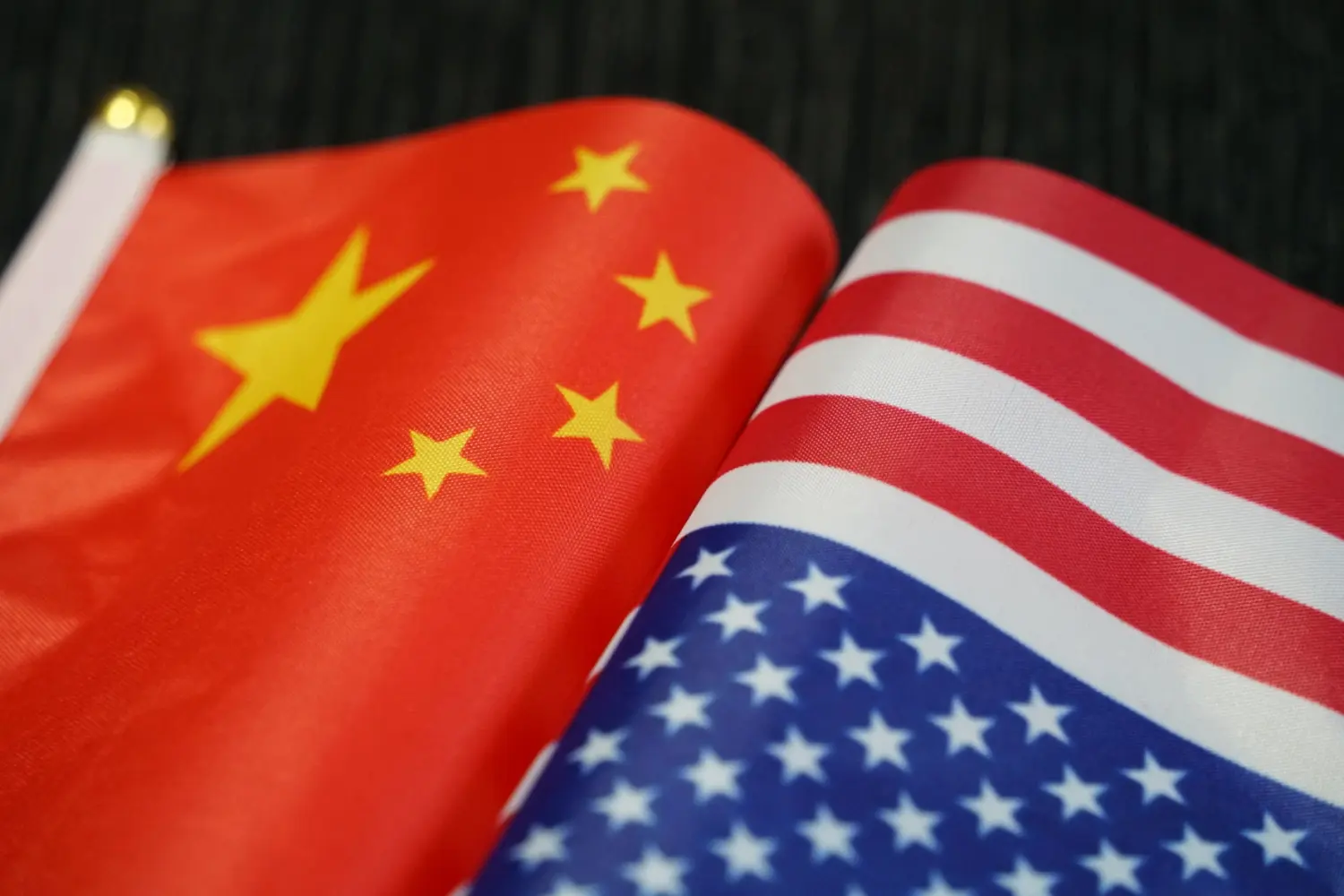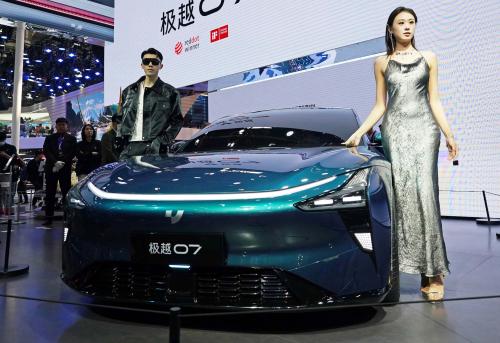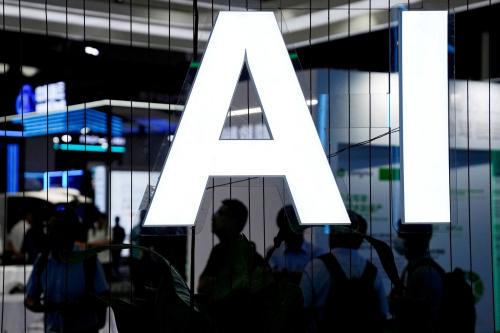The fates of breakthrough technologies and the energy to power them are deeply interwoven, with progress at scale in one difficult to advance without the other. Nowhere is this interconnection more consequential—and more dynamic—than in the U.S.-China relationship, which is marked by intense political tensions and competition, but also by under-appreciated technical overlap. Given the inescapably interconnected nature of digital and energy systems, and of U.S. and Chinese progress there-within, current and future U.S. administrations will need to consider both together, making conscious decisions about how technology investments may drive new frontiers in energy production, and how new energy innovations will be essential to progress in applied and cross-cutting technology priority areas like artificial intelligence (AI).
The race to develop, control, and power AI offers a particularly clear lens through which to observe these intertwined dynamics, as technological developments fuel competition, and where that competition shapes each country’s energy choices. The policy moves Washington and Beijing make in prioritizing demand drivers like AI and in turn confronting the energy demand challenges AI creates; dealing with the security consequences of smarter grids; and investing in global market expanders like standardization all have strategic consequences for both countries’ competitiveness in energy and technology.
While the United States will face a range of choices when addressing the dual imperatives of maintaining energy security and driving technological innovation, most important to success will be recognizing the extent to which one depends on the other. This dynamic is emblematic in AI, as this paper will explore, with similar dynamics likely to play out across technological innovations, and for energy security, on which so many sectors rely. Putting into place a clear strategy—one that recognizes this interplay and harnesses the multipliers of private sector investment—will confer not just strategic advantage but could also offer platforms for multilateral and even bilateral cooperation, on the basis of mutual interest, as shared concerns about AI animate policy discussions in both capitals.
The AI demand driver
AI systems in their present form are notorious energy consumers, a demand burden potentially borne by the U.S. and Chinese grids that may strain long-standing projections of energy demand. While AI by no means accounts for the bulk of growing energy demand globally, its significant needs, rapid emergence, and mass diffusion provide a window into a new and importantly disruptive dynamic to clean energy plans around the globe.
Straining demand. Prior to the development of AI systems at scale, a relatively stable dynamic existed between the increasing need for energy-intensive data centers and the efficiency of the machines within those data centers. As a result, in the decade before modern AI systems came of age (roughly 2005-2016), the energy being consumed by U.S. data centers was relatively flat, as efficiency counterbalanced the growing number of data centers. However, as the world’s most data-intensive and data-center-operating firms like Amazon, Alphabet’s Google, and Meta’s Facebook began to seize the business benefits of advanced machine learning—the underlying science that would drive “generative” tools like ChatGPT in recent years—the necessary shift to particularly energy-intensive hardware led energy consumption to more than double in the five years that followed (2017-2023).
The demand spikes caused by AI take many forms. Training advanced AI systems creates needs among single, large power consumers that may rapidly outstrip any ability to serve them, let alone with the clean energy they increasingly seek. While estimates vary wildly, parsing available research and companies’ own statements suggests that training (which is to say building for consumer use) the current, cutting-edge models available today is estimated to have expended tens of megawatts per model. The “scaling laws”1 that many AI companies are using to project future demand and acquire energy capacity suggest a multi-gigawatt annual need in just a few years to develop and sustain next-generation systems. This energy need would translate into one widely used “frontier” AI model’s training, consuming perhaps as much electricity as 5 million U.S. households in a year. Increases in the efficiency of the chips used to train most AI systems, as well as in how those processors are used, could prevent a worst-case scenario of runaway consumption—but with longer “training runs” becoming the norm, those gains may have difficulty offsetting the growth in the computational intensity/duration of a training process itself.
Yet a less appreciated but also significant demand driver will be the cost of actually utilizing AI systems to perform functions, so-called “inference” (literally querying an AI model, whether for an answer to a text-based question, to seek the generation of an image, etc.). What many would think of as a “standard” search engine inquiry, made instead with a large language model (LLM), is widely estimated to require 10 times the electricity to deliver a similar result—though, without providing details or baselines, some in the industry have claimed simple queries demand far less. Yet models are capable of much more than just text generation, with other capabilities such as image or video generation demanding more inference per input, and in turn, increasing the energy used to generate an output. Precise estimates of inference cost depend not just on the query’s type and complexity but on the number of “parameters” an underlying model (ChatGPT or Meta’s Llama) has. Though the landscape changes daily, as of this writing, capable AI models range from just under 10 billion for the smallest, to tens to hundreds of billions for so-called “multimodal” models capable of handling and outputting images in addition to text, to (an estimated) more than 1 trillion for the largest such models. Energy usage does not perfectly track the increase in parameters, but it does provide directional indications, with additional fluctuations based on factors like whether computation needs to be spread across multiple processors within data centers. Increasingly, incurring that energy cost may also be inescapable for consumers, as companies embed LLM-driven results into even basic web searches. As a result, which models become “default” for queries at a global scale (e.g., when an iPhone user does a web search in their phone’s browser) or even formally standardized (as discussed below), can matter immensely for aggregate AI energy consumption.
Enduring strategic focus. A pivotal question is whether AI will remain of strategic significance, particularly in the U.S.-China relationship, in the decade-long timescale on which many energy decisions are made. Based on current evidence, it is unlikely that the race to develop better, more capable AI systems will be diminished in the second Trump administration. Despite some critics’ expectations of another “AI winter” or that these technologies will fail to deliver national-level economic impact, the second Trump administration’s personnel and policy choices give little indication that it anticipates a cooling of the issue in the context of foreign policy. President Donald Trump’s appointment of several technology figures—some with significant experience working on AI in the first Trump administration—on the day-one White House team, combined with the creation of an elevated White House AI (and crypto) czar within the organizational hierarchy, suggests AI’s continuity as a high-tier policy concern. In the administration’s opening weeks, it released an executive order stating “we can solidify our position as the global leader in AI,” which sought to review (but not wholesale stop the work of) President Joe Biden’s main AI order. Days later, it devoted Vice President JD Vance’s first international speech entirely to the topic of AI. Much was made of that speech’s calls to reconsider the prior administration’s safety-focused approach to AI. Yet beyond the headlines, notable continuity prevailed. On the characterization of the challenge, Vance pointed to how “hostile foreign adversaries have weaponized AI,” just as Biden focused on “use of AI systems by adversaries and other foreign actors.” And both drew attention to energy as a key vector of that AI competition, with last-minute moves by the Biden administration to try to accelerate the growth of energy infrastructure for U.S. AI firms echoing Vance’s claims that “we stand now at the frontier of an AI industry that is hungry for reliable power.” Vance continued, “AI cannot take off unless the world builds the energy infrastructure to support it,” and he even opined that “it will help us create and store new modes of power in the future.” In the geopolitical competition for AI, energy is envisaged, across administrations, as critical.
In China, President Xi Jinping has consistently cited various constructions of how “China attaches great importance to the development of AI” and must “aim at the commanding heights of future science and technology and industrial innovation,” focusing in particular on “artificial intelligence” and “new energy.” While the tie between energy and AI development has not yet been stressed as explicitly in Beijing’s rhetoric as in Washington’s, the relationship between the two was cited in Xi’s calls for a “major strategic deployment for building a new power system” and the “empowerment of new technologies.” Beijing’s AI push, for its part, has continued despite China’s significant headwinds for the technology sector: namely, crackdowns on the technology sector in recent years. Leading AI capabilities continue to emerge from researchers, startups, and established firms alike. (Though as in the United States, a healthy—if distinct—debate may be taking place in China’s elite political circles about the socioeconomic puts and takes of accelerating AI’s development.) While many have covered the progress Chinese companies have had on AI development, including DeepSeek’s surprise release of a model rivaling some leading American competitors, a counterintuitive metric of the significance China is placing on its AI progress may be the lengths to which Beijing is going to bring it to heel. New requirements for registration and rigorous testing to ensure query responses dutifully comply with political diktats—with AI developers privately lamenting the performance consequences—suggest significant expectations for AI’s permeation into the economy and broad consumer use. On the other side of the spectrum, that AI represented one of the rare new areas of diplomatic exchange, ultimately yielding reciprocal leader-level statements about the inadvisability of using AI systems in nuclear command and control, speaks at a minimum to the ongoing military anxieties about the technology. The ever-greater push for more AI capability is driven by market demand but stoked by geopolitics; in competition with the United States, quenching AI’s need for energy will be a measure of Beijing’s internal success not just in economic competition, but in the geopolitical advantage AI confers—and that China so actively seeks.
Upstream alternatives
Shopping abroad. With the trajectory of AI development and utilization unlikely to subside on either side of the Pacific, questions arise over alternatives to the U.S. and Chinese grids fully shouldering AI’s energy burden. To that end, countries like the United Arab Emirates are working to lure U.S. (and presumably Chinese) AI companies to do their energy-intensive training far from home. These investments are worthy of attention; with capital that can dwarf U.S. venture and private equity offerings, and the appeal of broader packages to support companies’ competitive edge, they are likely to become bludgeons in domestic negotiations. That said, the practical and regulatory challenges to significant offshoring of model training make this an outside prospect, at scale and in the near-term. A growing thicket of domestic data sovereignty rules and active litigation over copyright violations may well complicate frontier model companies’ willingness to train such expensive models overseas. Even deals like Saudi Arabia-based (and sovereign-backed) Humain’s large purchase of cutting-edge Nvidia chips for AI training are more likely to be deployed for domestic model development and inference than a replacement for significant U.S. frontier model training.2 Rather, to power the most substantial data center use, both U.S. and Chinese AI companies may have to (or will be compelled to) make do with the grids they have, and lean as they are on government leadership for more supply and prioritization. It is here that divergent approaches in the United States and China could become particularly interesting.
More with less? Not yet three years into the era of “armchair AI” (general-purpose systems, available to most anyone), both countries are still in the early days of this technology’s evolution. In the United States, the lavish funds being invested in new AI companies and the cash-flush tech incumbents showering funds on training AI models on the data they already possess mean this is a subsector unaccustomed to deprivation. The question is one of market trajectory: will revenues from the use of these models, combined with investors’ appetite to invest in their potential, be a motivator for greater efficiency—or such an accelerant to business competition that energy efficiency becomes a secondary priority to overall model performance?
To be clear, academic computer science research has long prized more computationally efficient ways of delivering AI models, and the companies themselves have a clear profit motive to bring down training costs. A central question for the field—and indeed, for the future of clean energy globally—is whether new computational techniques can permanently arrest the exponential energy costs that are a present corollary to the “scaling laws.” The early state and important breakthroughs in this research suggest there may be; beyond existing market drivers, government incentives to focus minds on this set of areas could provide outsized returns, when the broader clean energy picture is taken into account. (It could also, if improperly managed, simply create greater demand, as costs of AI inference plummet even more quickly than in years past.)
But this is an area where such a breakthrough would be unlikely to stay a state secret for long; behind the rhetoric of U.S.-China decoupling, the reality is a much more nuanced story of frequent mutualism between international technical AI researchers, coupled with a culture of open publication as a significant norm and means of validation in the field. While state investments in dramatically more efficient AI training may solve energy challenges, they may end up being a point of parallel progress or even cooperation, rather than conferring strategic advantage to one side or the other.
Sparking fission? Tech giants’ recent moves to acquire dedicated nuclear fission plants to service their demand may be a tipping point in the fast-changing global debate over nuclear energy. Indeed, in a moment of U.S. political transition and deep fissures over climate investments, nuclear fission offers an area of potential political détente: not “so green” to turn off the political right, yet not carbon-intensive enough to court the most vociferous opposition from the left. Whether AI firms are effectively triangulating this area of potential overlap; piling onto evolving views on the technology given the political climate and reliable, baseload energy imperatives; or simply short on alternatives to meet their demand needs, the result is the same: nuclear fission may be the stopgap measure investors and AI leaders need to have confidence they can continue building ever-more-energy-intensive models—despite the unattractive regulatory timelines and lack of popular consensus on fission’s deployment. In this respect, the federal lawsuit challenging the Nuclear Regulatory Commission’s oversight of modern small modular reactors will be one to watch for this sector and those planning to rely on small modular reactors to meet growing energy use projections.
A related dynamic is playing out in China, with government planners engaged in a similarly delicate dance around untested public opinion linking data centers to nuclear power expansion. To look at one example, China’s “Eastern Data, Western Computing” (东数西算) initiative to build data centers to power its growing compute needs is colliding with set policy goals to power them with 80% clean energy by 2025. Notably absent from the explanations of “how” is any inclusion of nuclear power. This is a material and telling omission, suggesting either that in the context of data centers, Chinese planners do not yet see the public as primed to accept data centers as a reason for major nuclear energy expansion (despite that such a nuclear expansion is long underway, for other reasons), that grid-scale battery storage will make major breakthroughs in only a few years, or both. In both cases, utilization of nuclear fission may indeed be meaningfully driven by private AI and data-intensive firms’ rapid need for it—and commercial interest in normalizing it nationwide—paving the way for a warmer welcome into policymakers’ desired clean energy mix than publics may have to the technology.
Betting on fusion? AI demand needs are also accelerating—and partially financing—the United States’ strategic investments in as-yet-undeployed long-term clean alternatives, namely fusion energy. While the list of investors in the technology includes a range of institutional finance, venture capital, and strategic industrial players, current and former founders/CEOs of the largest AI and tech giants have played significant financial and organizational roles in the firms. For perspective, a single investment from just one of those “big tech” players dwarfs (over seven-fold) total federal funding to private fusion under its signature “Milestone-based” Fusion Development Program designed to help commercialize the technology.3 In the summer of 2025, Google alone announced two separate investments in, and aspirational agreements to purchase power from, U.S. fusion firms. Time and again in recent months, these commercial fusion bets by tech firms seem underwritten by AI’s power needs and, in turn, national AI competitiveness. Bipartisan U.S. enthusiasm for fusion was clear, if tentative, given the lack of demonstration power plants under both the first Trump and Biden administrations. Beijing, for its part, has redoubled its state investments in fusion, a move not lost on U.S. fusion officials. Jean Paul Allain, the head of the Department of Energy’s fusion science program, said in a recent interview that more than just the estimated $1 billion to $1.5 billion Beijing is pumping into its domestic fusion program annually, “To me, what’s more important than the number, it’s actually how fast they’re doing this.” Here, the AI race is in part driving, and shaping, the next chapter of the clean energy race. And some lead commercial fusion firms, for their part, are pinning some of their near-term hopes on the demand jolts the sector is publicly confronting.
Downstream drivers
To what extent will the United States or China seize other advantages at the intersection of clean energy and emerging technology to improve their competitive advantage—or even use them to build new areas of cooperation—has yet to be seen. But in at least two areas, grid cybersecurity and standardization, the imperatives of the moment may be important contributors to the overall tenor of U.S.-China relations even more than their direct effects on energy policy.
A better, brittle grid. One inheritance of the significant increases in energy demand, driven in part by AI, will be prompting necessary upgrades to public grids that are not up to the task of supporting new clean energy onboarding, let alone significant demand spikes. From smarter metering to grid-enhancing technologies, the digitization of electric grids supported by immense public spending (such as the U.S. Inflation Reduction Act) poses opportunities for efficiency but also carries a notable risk: introducing new brittleness to the grid via cybersecurity vulnerabilities, allowing remote sabotage on a scale once only feared. This concern has been known for decades and rehearsed in other regions by other U.S. adversaries, but it has returned to the fore with the recent string of discoveries of “kill switch” capabilities implanted in U.S. critical infrastructure and attributed to China—actions the director of the U.S. National Security Agency called “unique and different.” Beijing has, in typical fashion, denied responsibility for these hacks, but U.S. attribution has yet to draw a serious challenge. Increased upgrades to the grid, driven by clean energy investments and growing demand, yield greater cyber vulnerability. As both nations modernize their grids, each will introduce more digital elements that can be commandeered, disabled, or maliciously activated—a growing, mutual vulnerability. Cognizable “attacks” or episodes of sabotage could range from selective blackouts of critical facilities, straining areas where grids are already overtaxed, and potentially large-scale cascading failures in regional grids. Scenarios like these were seemingly contemplated when the Biden administration moved to ban Chinese software in U.S. vehicles, given that the vehicles themselves serve as significant nodes on the grid—which, if manipulated at once, could cause such blackouts.
This dynamic—and the potential for deep mistrust—is likely to expand in the bilateral relationship in the years to come. It is too soon to say whether there is potential to reduce the level of tension on this matter, despite China’s once-expressed interest in bilateral commitments. The United States could substantially upgrade—and sharpen—its push for certain cyber norms of behavior, extending the focus beyond commercial secret theft. That effort was unusual in producing a measurable, if temporary, change in Beijing’s willingness to pilfer certain U.S. digital systems at their prior scale.4 Thus far, such pursuits at true restraint have been assumed by both sides to be half-hearted, insincere, or both, raising the question of just what level of risk will be necessary to bring both sides to a serious negotiating table. With the stakes arguably far higher than they were in the mid-2010s, the time is ripe to explore the avenues to escape this destabilizing dynamic.
The standards dividend. A final dynamic worth noting is competition over technological standardization—deeply competitive in the context of telecommunications (most notably 5G and internet standards)—and potentially market- and relationship-shaping in emerging technology and clean energy spaces as well. The day-to-day of standards development is often grinding and jargon-filled, as engineers, scientists, and increasingly, national officials seek agreement on the architectural lattices of new technologies. In what was once thought of in the United States as an industry-led and largely hands-off approach to avoid picking winners and losers, a focus on national leadership in standards accompanied the Biden administration’s greater intentionality of industrial policy. Not to be outdone, Chinese officials have echoed these sentiments in an explicit three-year national action plan—crystallizing a strategy long alleged by U.S. officials but largely left unspoken in official Chinese documents in the decades prior. The Chinese strategy aims to focus work on securing a range of technological standards for the Chinese technological ecosystem, with a prime focus on AI (among other emerging technologies, including quantum computing and brain-computer interfaces). In this respect, both countries have now explicitly recognized that in AI, as with many technologies before it, holding standards confers a significant dividend to the broader innovation ecosystem within a sector—telecom, AI, or otherwise.
Despite those outsized returns, substantial questions remain about states’ ability and interest in following through on these grand ambitions of continued standards involvement. In some areas of clean energy, early competition is already underway. On emerging technologies like fusion energy, Chinese companies have been hard at work at the International Standards Organization to standardize a version of the technology in which they have invested most significantly. But clean energy technologies are neither cell phones nor web protocols; jurisdictions vary, and securing standardization at official standards development organizations (SDOs) can take a back seat to substantial market players like Tesla getting large-scale traction with proprietary standards. The Tesla charging standard, now rebranded to the North American Charging Standard, or NACS, to encourage adoption, is one such example—largely bypassing SDOs and adding new complexity to a model in which states exert official or unofficial pressure at established SDOs. And although under the first Trump administration, focus on 5G, secure telecommunications, and other standards-relevant areas sidestepped broader curbs on international engagement, it remains to be seen whether declining budgets and headcount, combined with institutional reorganizations, will hamstring this intensive diplomatic task. For clean energy, the level of state involvement in other standards processes, such as those over renewables failure modes and analytics, energy management systems, and components of energy storage systems, may offer early clues.
Charting an interwoven future
The future for energy and emerging technologies is as interwoven—and at times as fraught—as the U.S.-China relationship. These relationships are hardly zero-sum, but deserve to be considered in concert with one another, and most importantly, as part of a coherent strategy for the United States that intends to put China and energy security atop its agenda. Smart investments in commercializable energy breakthroughs, market-complementary incentives to drive more efficient AI models and inference, and diplomatic engagement to ensure the most promising technologies achieve standardization all drive at the same strategic imperatives. While other factors will shape this emerging dynamic—from Taiwan’s role in semiconductor manufacturing to critical mineral resources in Southeast Asia—this moment represents an opportunity to consider the broader picture and accelerate both technological and energy needs in concert.
-
Acknowledgements and disclosures
In addition to his nonresident affiliation with Brookings, the author is managing director of a global advisory firm that counsels and invests in a range of emerging technologies, including some technologies discussed generally in this article.
-
Footnotes
- While stated by company leaders as absolutes, these “scaling laws” are really empirical generalizations extrapolating from past experience; as later sections explore, they are a hypothesis at best.
- A key question remains as to whether this detail precludes Humain from making these chips available to Chinese firms or cutouts—as existing U.S. export controls intend—or whether this deal might also provide a means to soothe tensions with Beijing by providing a limited third-country source of access, now or in the future.
- Overall, the Biden administration spent roughly $800 million per year on the broader scientific fusion enterprise, but around 5.75% of that went to grants to private companies commercializing fusion—a marked contrast from other energy technologies lavished with funding for private projects under the Inflation Reduction Act.
- An alternative argument holds that China simply changed its tradecraft to use more sophisticated and otherwise undetected tools for this theft; while possible, no persuasive forensic evidence has been presented to support it, while significant evidence supports that Beijing did actually taper off such conduct for a period of time.
The Brookings Institution is committed to quality, independence, and impact.
We are supported by a diverse array of funders. In line with our values and policies, each Brookings publication represents the sole views of its author(s).








Commentary
Interwoven frontiers: Energy, AI, and US-China competition
August 11, 2025